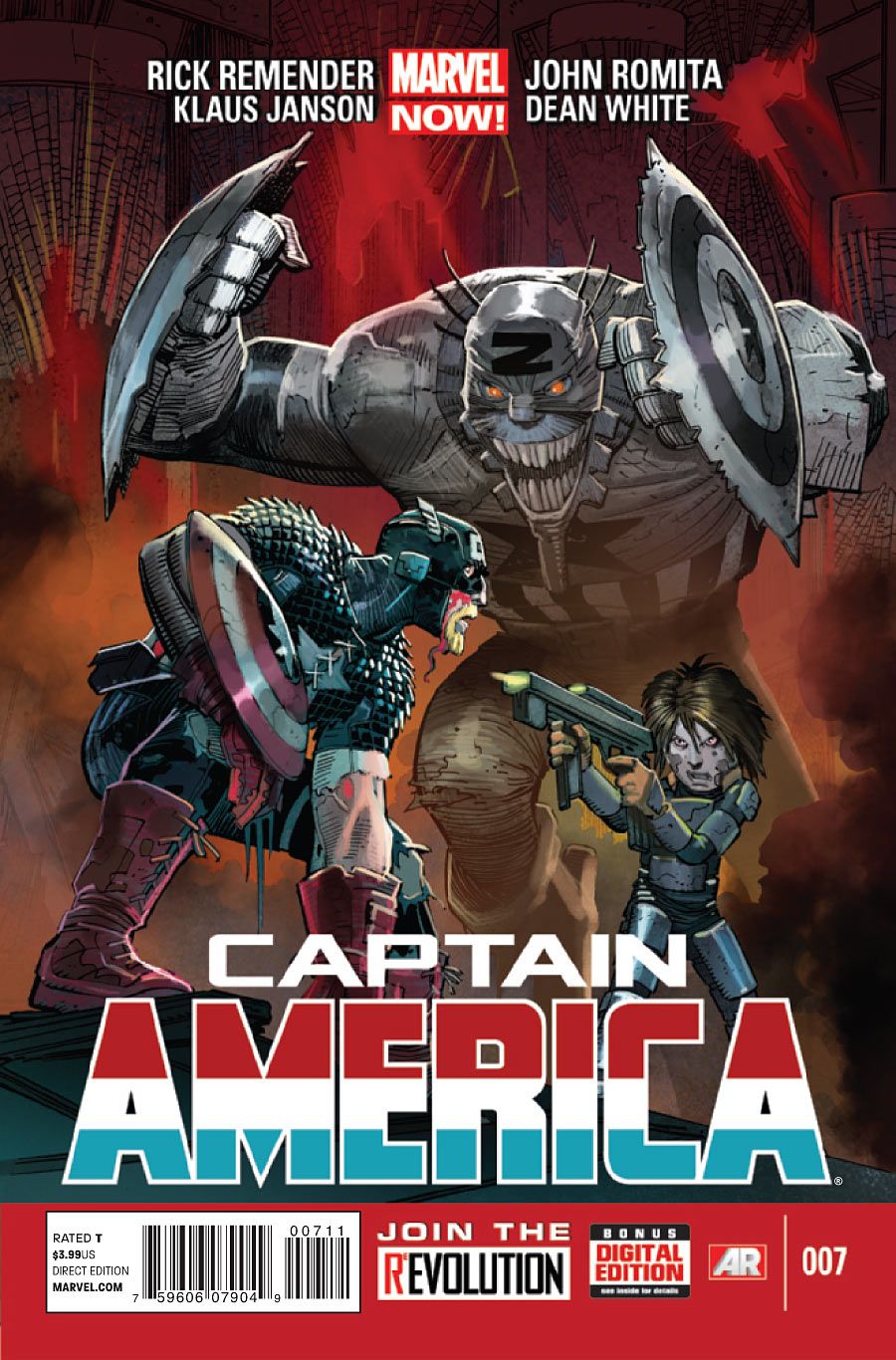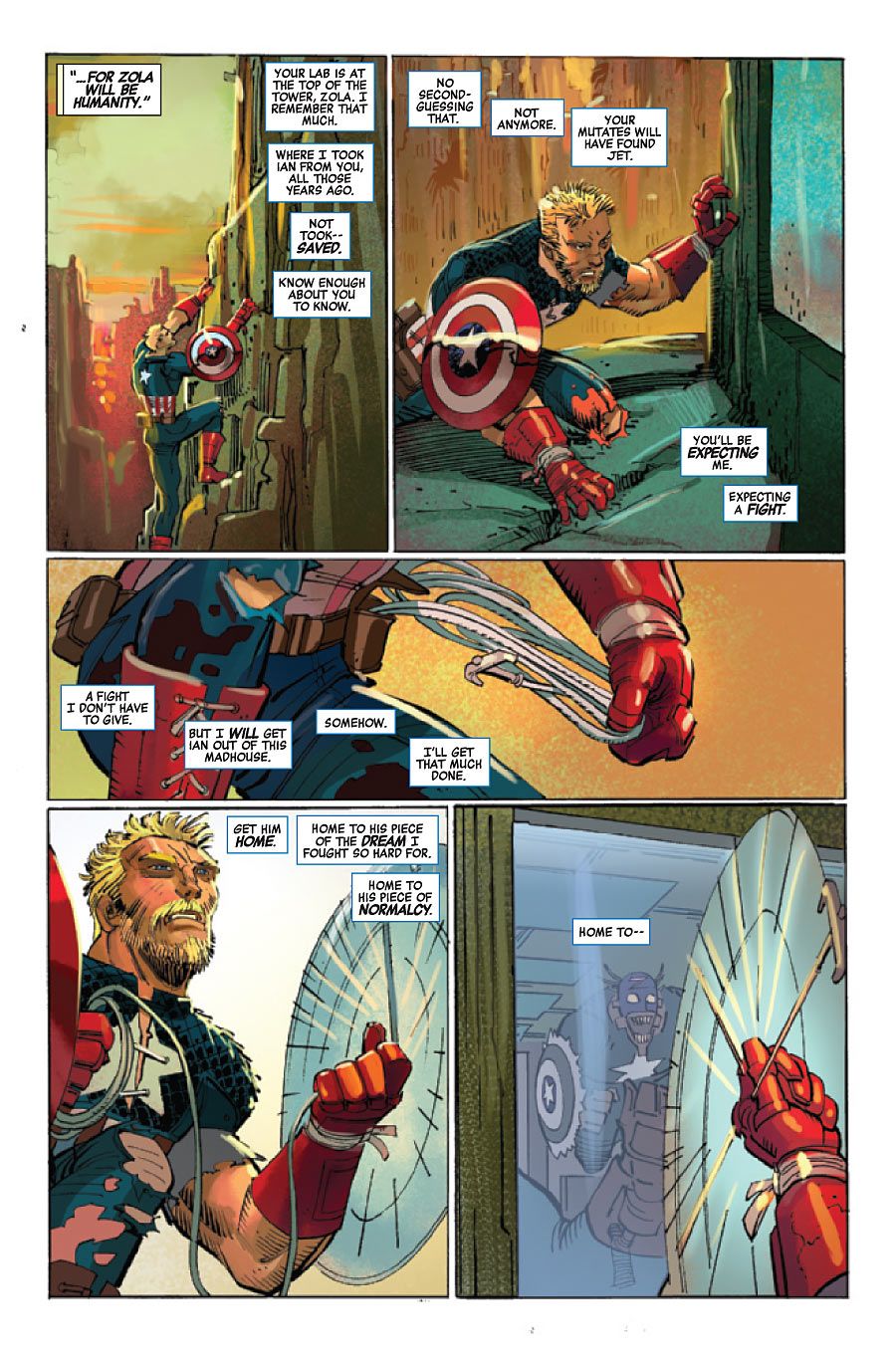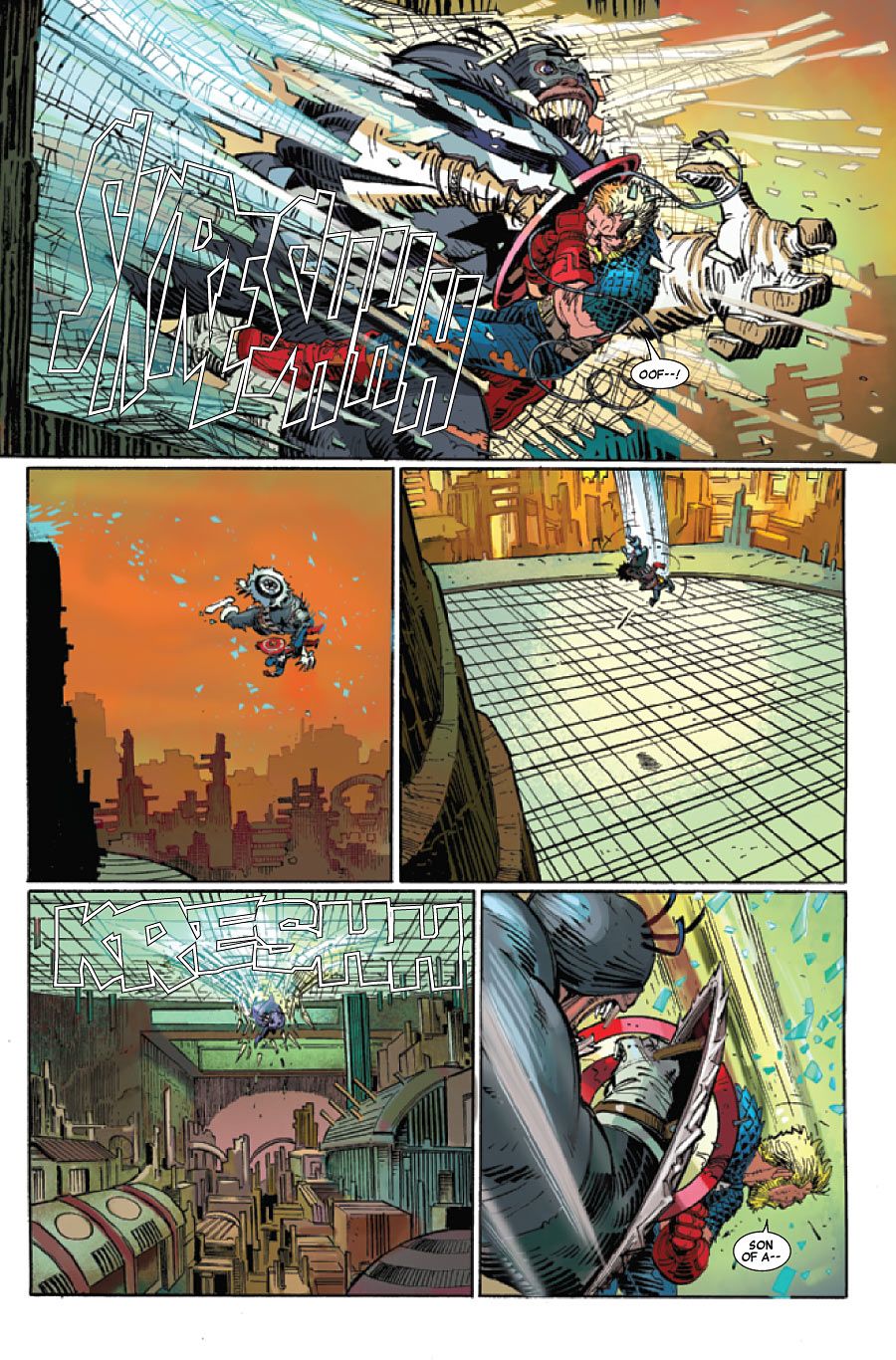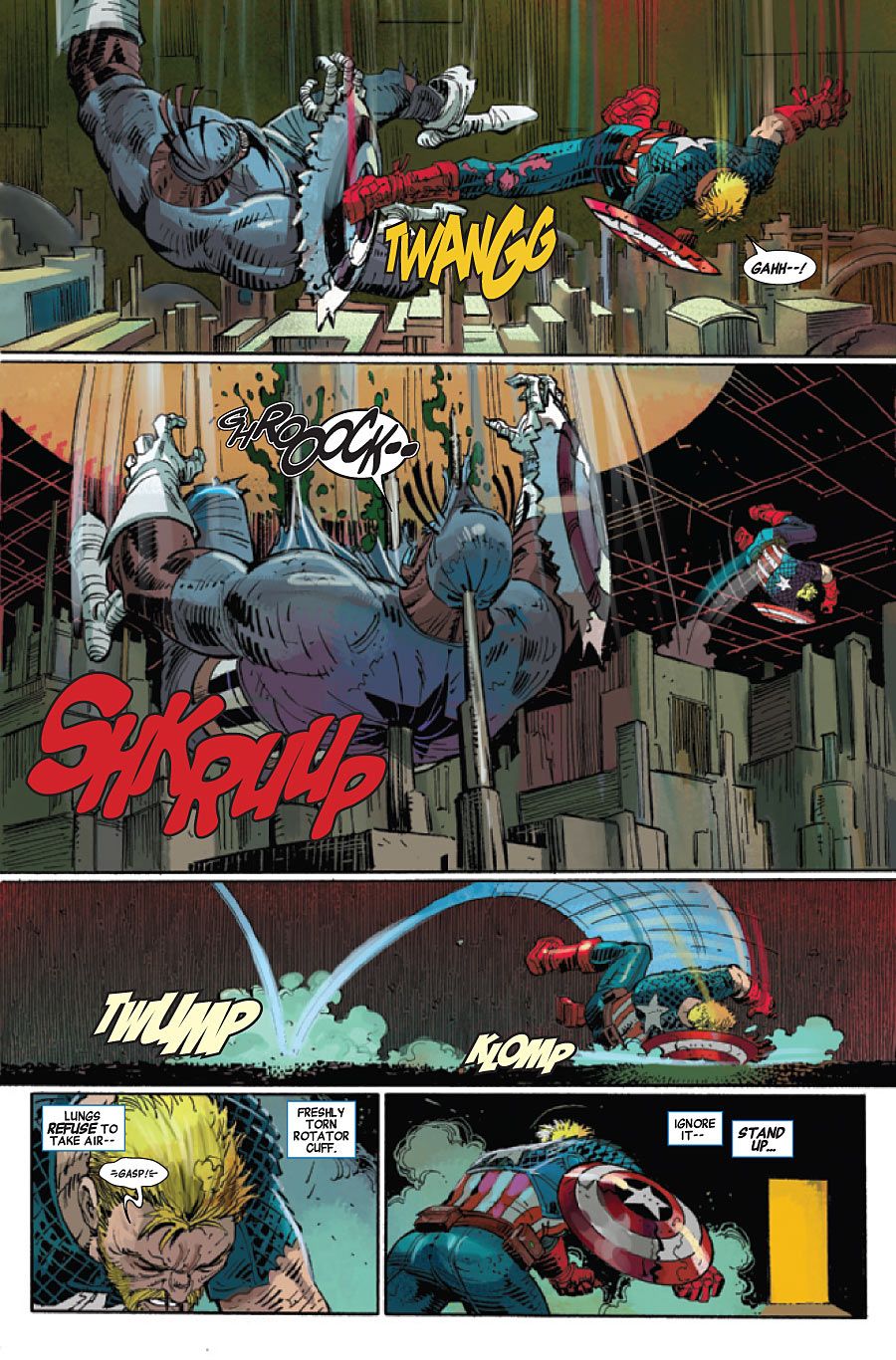During World War II, the American scientists of the Marvel Universe embarked on a program that would create an army of super soldiers to help them defeat the Axis Powers. Due to Nazi sabotage Operation Rebirth only created one such soldier, Steve Rogers, who was transformed from a frail youth into a specimen of physical perfection. That one soldier was more than enough though, because Rogers became more than a soldier when he donned a star spangled costume and picked up an indestructible shield; he became Captain America, the living symbol of his country's ideals.
Captain America's fighting skills, iron will and dedication to the paradigms of freedom and justice helped inspire many soldiers during World War II, as well as the costumed heroes that followed him when he was found frozen in a block of ice in modern times and joined the Avengers. In the debut issue of his new self-titled Marvel NOW! series writer Rick Remender and artist John Romita Jr. thrust Cap into a new war that would test his mettle and his devotion to his ideals. That war is being waged in a strange and nightmarish reality known as Dimension Z, and it's against Cap's old foe, Arnim Zola, the Bio-Fanatic who rules over the dimension with an iron fist.
From the very beginning, Cap's war with Zola has been a complicated one. When he arrived in Dimension Z Cap rescued the villain's infant son from Zola's laboratory and spent years raising him. Cap now considers the boy, Ian, to be his son and recently Zola began an offensive that left Cap beaten and battered -- and Ian in the Bio-Fanatic's clutches. As the final act of the Dimension Z Saga approaches, the question becomes what will Captain America do to get his son back? And what exactly is Arnim Zola's master plan? For the answers to those questions and more Comic Book Resources spoke with Remender about his plans for the series.
In "Captain America" #6 Steve Rogers began the battle to get his son back, by infiltrating Zolandia, the Capital City of Dimension Z. The way he entered the city and dispatched the forces that tried to block his way showed that the Sentinel of Liberty's quest to save his son is fueled by a sense of both urgency and desperation.
"One of the things we're exploring here is that Steve has been in Dimension Z now longer than he's been in Modern America. So this place has become his home. Now obviously we've been doing this story line for just a few issues. I could have written it for 5 years though, and we'll have flashbacks to show a lot of the missing pieces from his time here," Remender told CBR News. "So this is his normal and Ian is Steve's son for all intents and purposes. Now Zola has crept back into their lives and taken Ian, who was the one thing that Steve had left. Ian gave him a purpose in this world. Steve cared for him and tried to raise him in a way that meets his ethical compass and his standards.
"That meant keeping him safe and keeping him away from his biological father's evil influence. Now that Zola has taken Ian, I don't think Steve has lost his mind, but we're seeing a side of him we haven't seen in awhile," Remender continued. "Desperate is the right word to describe him, but also determined. The idea with our flashbacks in my first few issues was to show how young Steve was shaped by the subtle lessons he learned living with his mother and grandfather during the Great Depression. We're all shaped by these quiet and sometimes not so quiet moments and events from our childhood that teach us these lessons that we hold onto and add some semblance, and even sanity to our otherwise chaotic world."
At the end of "Captain America" #5 Zola and his forces destroyed the home of the Phrox, the alien tribe Cap and Ian had lived with for years. During the assault Zola took Ian and threw Cap off a cliff. At the end of the issue readers saw the Sentinel of of Liberty get back up by drawing on the values that have been guiding him ever since his childhood as a frail youth growing up on mean streets of Depression era New York City. He then silenced the duplicate Zola consciousness the Bio-Fanatic had implanted in his chest and vowed to get his son back.
"The principles of not abandoning those who need him and always standing up no matter what are what keeps Captain America going and what cause him to get back up after any beating," Remender explained. "So villains can try to lay him low in the same kind of way that the Kingpin did to Daredevil in 'Born Again,' but there is no laying Steve low. You kill him or he stands back up. There's no scene where Steve falls down and sinks into the gutter. He's never going to do that. That's what I wanted to show. I wanted to come up with a scenario that was as awful as possible and then show that you can't get this guy down. That's how I see Captain America. So where he's at right now is that he's had his life completely shattered yet again, but he took a machete and carved the Zola implant out of his chest to shut it up! And now he's coming back to get his boy."
Cap may be back on his feet after taking a beating from Zola and carving the implant from his chest, but that doesn't mean he's not feeling the physical effects of all he's been through. "He's in rough shape and it's only going to get worse and worse," Remender said with a laugh. "We're going to see what can happen to this guy and how he can still manage to find the inner resolve to get back up and to keep moving forward. It is a very obvious metaphor, but it's one that I thought was useful in examining this character and what's at his iron and concrete core. I wanted to really examine that and remind people here, at the beginning of my run, who this guy is. No matter what you do he's going to stand up."
While Rogers was trying to infiltrate Zolandia in "Captain America" #6 Ian's villainous biological father was trying to win his favor. One of the ways he sought to do this was by telling his son about his past and claiming he loved the boy's mother very much.
"Zola is a true sociopath and they don't experience love in the same way. He felt what any sociopath feels for their mate, which is that they're a tool to be used and manipulated for their own ends," Remender explained. "So they don't have an emotional stake in the relationship, but all sociopaths learn to mimic human emotions pretty well and in a way that lets them manipulate those around them and ultimately ends in them acquiring whatever their goal is. That's a lot of what you're seeing with Zola.
"He did have a wife. I wrote the whole back story about Zola's wife and maybe one day I'll actually show what happened to her and what he did with her. I've shown bits and pieces of that throughout our story," Remender continued. "I gave you some hints of it in issue #4 where the Zola consciousness that was affecting Steve reveals that he took his wife as she was trying to leave him and forced her into this incubation tank where he cloned her and he's been using her genetic material to try and make the perfect offspring."
Ian experienced his first encounter with his biological father in "Captain America" #5. That's also where he met his sister Jet Black, who's been raised by her father and taught his twisted ideals. That issue also featured Jet's first meeting with Captain America, a man she was raised to hate. It was a brief encounter, but it left her with questions about herself, her hated foe and the world they both currently inhabit.
"She's lived in a world ruled by her father where she's been treated as a princess and she's been taught that life is about survival of the fittest, kindness is weakness, mercy is foolishness and being softhearted is true evil. So like any child indoctrinated from birth with her father's philosophies on life, she's not had other spectrums through which to see reality," Remender said. "Then here she is in a battle fighting who she thought was a hated, evil enemy in Captain America. He was a man who kidnapped her brother, and then shows mercy. It's a concept she's never been privy to in her life, and here was this guy who had every reason and opportunity to kill her showing her mercy even though it would make his life more difficult.
"Now she's discovering that Cap left her alive for a number of reasons, and on top of that he left Ian with her to take care of him. So she watched Steve put Ian before himself and show Mercy to his enemy. That confused her and I think it's started to unravel her intellectual curiosity about these concepts she's been taught to abhor," Remender continued. "Plus, Steve Rogers is a handsome guy and he's the only handsome human being she's ever seen. So there are also some womanly urges stirring in the background there."
Zola knows Captain America's encounter with Jet had a profound impact on his daughter and the Bio-Fanatic values her just as much as he does Ian. In issue #6 readers saw some of the cruel measures he's implemented to try and maintain control over her.
"Zola is a monster, but his actions are not governed by hatreds like racism or misogyny. He's all about intellectual curiosity at any cost. Life to him is clay to be molded and played with as he sees fit. He has no empathy for how it makes his subjects feel and doesn't care what it does to them," Remender explained. "So his son and his daughter are equally important because he's spent all of his time creating the perfect offspring. He's gone through numerous versions of them which have been imperfect and he has discarded. He bioengineered the physical perfection of Ian and Jet in the same way the Super Soldier Serum added that to Steve.
"He wanted that serum from Steve's blood to give to his kids as well to really solidify their physical perfection and lock everything in place. That was the big reason why he brought Steve to Dimension Z. That went a little sideways on him. So in his own way he loves Jet and Ian," Remender continued. "It might not be love as we understand it, it might be love from a more egotistical stand point where because they represents the ideal genetic representation of him and his potential in his offspring. So he loves kids in the same way he loves himself. That's really the only love a sociopath can feel; their own entitlement and their own love of self."
Zola may feel entitled to perform horrific and perverse experiments to further his understanding of science, but that doesn't mean society would allow him to perform them, especially the early 20th century society of his birth. When World II arose though he found the perfect patrons to indulge his sinister scientific pursuits, the Nazi Party. "Zola may have worked for the Nazis, but I don't see him as one, " Remender remarked. "I see the Nazis as a system of government and a political party that were willing to give him the tools he needed to further his experiments provided they were also getting something out of the deal. That's not retconning. I think we've seen enough examples of that. Viewing the Aryans as the perfect race doesn't really fit with how the character comes together. He sees everyone as biological clay for him to experiment on and jimmy with in his efforts to perfect it. Hence his title, the Bio-Fanatic. He's fanatic about taking the clay of life and trying to mold better things out of it."
Zola's fanaticism means he has bigger plans than just raising a family in another dimension. In "Captain America" #7 readers will start to find out what the Bio-Fanatic has ultimately been up to in Dimension Z.
"I've waited until the very end to reveal Zola's master plans because I wanted them to be revealed to the reader around the time they were revealed to Steve. This is the first time I haven't seeded the ticking clock or revealed what it is earlier so that you know what's going on. Instead, I reveal the ticking time bomb in issue #7 right around the time it starts going off," Remender explained. "All of a sudden that ramps up the tension and the danger and it ramps up the stakes in a way that are going to force Steve to move past his physical damage and mental damage. He's still got the virus that Zola implanted in him even [though] he hacked out the face of the thing to shut it up. So he's in rough shape. He's not doing well and now he has to contend with Jet and Zola himself. Plus he's got to try and rescue Ian and deal with the huge escalation in issue #7.
"Then I'll keep escalating things. The next few issues are nothing but reveals, a couple of which have been seeded," Remender continued. "When you get to issue #8, there's a tremendous reveal. Issues #8-10 are all payout. It's all the big, juicy stuff. You can only get the emotional impact I'm hoping to convey in issues #8-10 through a long build like we've had in issues #1-7."
"Captain America" #7 begins with a flashback before Remender picks up with the cliffhangers of issue #6, which left readers wondering if Steve Rogers had shot and killed Jet Black, and if Ian had succumbed to Arnim Zola's efforts to brainwash him. "There's a little flashback at the beginning of #7, and now when I do flashbacks it will be to Steve in Dimension Z raising Ian, as opposed to flashing back to World War II or before. I'm really trying my best to move this character forward into a bold new era that doesn't continually reflect a war that modern readers can't identify with as much," Remender stated. "Obviously World War II is a very fascinating period, but it's one that we've well explored with this character and his time in it. Now he's fought an entire other war in Dimension Z and that's something that I think is an interesting possible landscape to explore in these flashbacks."
Remender will bring the saga of Dimension Z to a close in August's "Captain America" #10 and before the epic is over the Sentinel of Liberty will have to find a way to overcome the scientific monstrosities that make up Arnim Zola's vast army, as well as the Bio-Fanatic whose consciousness now resides in a gigantic robot body himself. "Zola has created this big Destroyer-esque body for himself and given what he's been up to in Dimension Z he was was able to ramp up the technology that he he has at his disposal. So that body of his is hard core. He's put his prime consciousness in this war machine. It's basically his safety mechanism," Remender explained. "That's obviously not going to be something that Steve is going to have an easy time getting past. He might not even get past it given the way things are playing out. All the big payout beats are coming. You'll see how Steve deals with the physical threat of Zola in a couple of months."
In "Captain America" #11 Remender kicks off a new story line, but the events of Dimension Z will still loom large in the Sentinel of Liberty's life. Like his other books, the events of the writer's first few issues of "Captain America" will impact his Cap stories for months to come and possibly echo throughout his entire run on the book.
"I think the first five to ten issues of a series have a responsibility to set up things that will carry through for the rest. They're your first season, so to speak. If this is 'Breaking Bad' then my first ten issues are season one and that's all the inciting incident," the writer remarked. "I always write these things as 25 to 35-issue stories. Sometimes they'll have little breaks or little side stories and they go in different directions, you won't see the real ramifications of what you've seen in the first ten issues until issue #20. It's all big set up one for one big story."
"It's been great to write for John," Remender said of his collaborator on the relaunch, John Romita Jr. "It's a real treat and dream come true. He was a childhood hero of mine and even in art school John Romita Jr. and Al Williamson, when they were together on 'Daredevil,' produced pages that I studied as a penciller and an inker to try and pick up techniques. Plus, I get to work with Klaus Janson, Tom Palmer, and Scott Hanna who do our inks. Then to have Dean White come in and do his thing over every issue has made the book a real joy to behold."
"Captain America" #7 is on sale now.





